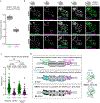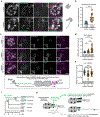Satellite DNA shapes dictate pericentromere packaging in female meiosis
- PMID: 39779853
- PMCID: PMC11880906
- DOI: 10.1038/s41586-024-08374-0
Satellite DNA shapes dictate pericentromere packaging in female meiosis
Abstract
The abundance and sequence of satellite DNA at and around centromeres is evolving rapidly despite the highly conserved and essential process through which the centromere directs chromosome inheritance1-3. The impact of such rapid evolution is unclear. Here we find that sequence-dependent DNA shape dictates packaging of pericentromeric satellites in female meiosis through a conserved DNA-shape-recognizing chromatin architectural protein, high mobility group AT-hook 1 (HMGA1)4,5. Pericentromeric heterochromatin in two closely related mouse species, M. musculus and M. spretus, forms on divergent satellites that differ by both density of narrow DNA minor grooves and HMGA1 recruitment. HMGA1 binds preferentially to M. musculus satellites, and depletion in M. musculus oocytes causes massive stretching of pericentromeric satellites, disruption of kinetochore organization and delays in bipolar spindle assembly. In M. musculus × spretus hybrid oocytes, HMGA1 depletion disproportionately impairs M. musculus pericentromeres and microtubule attachment to their kinetochores. Thus, DNA shape affects both pericentromere packaging and the segregation machinery. We propose that rapid evolution of centromere and pericentromere DNA does not disrupt these essential processes when the satellites adopt DNA shapes recognized by conserved architectural proteins (such as HMGA1). By packaging these satellites, architectural proteins become part of the centromeric and pericentromeric chromatin, suggesting an evolutionary strategy that lowers the cost of megabase-scale satellite expansion.
© 2025. The Author(s), under exclusive licence to Springer Nature Limited.
Conflict of interest statement
Competing interests: The authors declare no competing interests.
Figures














Similar articles
-
Centromeres drive and take a break.Chromosome Res. 2025 Aug 4;33(1):17. doi: 10.1007/s10577-025-09777-z. Chromosome Res. 2025. PMID: 40759764 Free PMC article. Review.
-
Spindle checkpoint can secure additional cheating time for selfish expanded centromeres.Curr Biol. 2025 Aug 4;35(15):3687-3696.e3. doi: 10.1016/j.cub.2025.06.056. Epub 2025 Jul 14. Curr Biol. 2025. PMID: 40664214
-
ZSCAN4 functions as a safeguard to maintain centromere integrity during oocyte meiosis.Genome Biol. 2025 Jul 15;26(1):204. doi: 10.1186/s13059-025-03687-3. Genome Biol. 2025. PMID: 40665375 Free PMC article.
-
Centromeres in the thermotolerant yeast K. marxianus mediate attachment to a single microtubule.Chromosome Res. 2025 Jul 3;33(1):14. doi: 10.1007/s10577-025-09772-4. Chromosome Res. 2025. PMID: 40608157 Free PMC article.
-
CENP-A and centromere evolution in equids.Chromosome Res. 2025 Jun 30;33(1):13. doi: 10.1007/s10577-025-09773-3. Chromosome Res. 2025. PMID: 40586953 Free PMC article. Review.
Cited by
-
Adaptive evolution of CENP-T modulates centromere binding.Curr Biol. 2025 Mar 10;35(5):1012-1022.e5. doi: 10.1016/j.cub.2025.01.017. Epub 2025 Feb 12. Curr Biol. 2025. PMID: 39947176
-
Species-specific satellite DNA composition dictates PRC1-mediated pericentric heterochromatin.bioRxiv [Preprint]. 2025 Mar 25:2024.10.11.617947. doi: 10.1101/2024.10.11.617947. bioRxiv. 2025. PMID: 39416160 Free PMC article. Preprint.
-
Forced expression of MSR repeat transcripts above a threshold limit breaks heterochromatin organisation.Nat Commun. 2025 Jul 11;16(1):6420. doi: 10.1038/s41467-025-61586-4. Nat Commun. 2025. PMID: 40645983 Free PMC article.
-
Telomere-to-telomere sequence of mouse haploid stem cells.Sci China Life Sci. 2025 May 28. doi: 10.1007/s11427-025-2919-4. Online ahead of print. Sci China Life Sci. 2025. PMID: 40451968 No abstract available.
-
Centromeres drive and take a break.Chromosome Res. 2025 Aug 4;33(1):17. doi: 10.1007/s10577-025-09777-z. Chromosome Res. 2025. PMID: 40759764 Free PMC article. Review.
References
-
- Henikoff S, Ahmad K & Malik HS The centromere paradox: stable inheritance with rapidly evolving DNA. Science 293, 1098–1102 (2001). - PubMed
-
- Strauss F & Varshavsky A A protein binds to a satellite DNA repeat at three specific sites that would be brought into mutual proximity by DNA folding in the nucleosome. Cell 37, 889–901 (1984). - PubMed
MeSH terms
Substances
Grants and funding
LinkOut - more resources
Full Text Sources
Molecular Biology Databases
Research Materials

